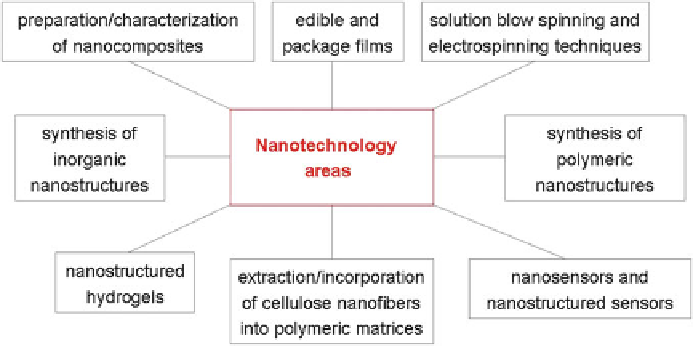Agriculture Reference
In-Depth Information
Fig. 5.2 Different nanomaterials or nanostructured materials used in the nanotechnology areas
Figure
5.2
shows the use of some nanomaterials or structured materials inside
the nanotechnology areas, including in water and wastewater treatment (Table
5.1
).
In their research review paper, Ghormade et al. (
2011
) discussed some applications
of nanotechnology in agriculture (Table
5.2
) and in nano-biotechnology areas
(Fig.
5.3
).
The fast and constant growth of technological innovations leads to profound
structural changes in the agricultural sector, with the aims of sustaining production,
improving food security (Brooks
2014
; Khoury et al.
2014
; Kim et al.
2014
),
poverty reduction (Dorosh and Mellor
2013
; Roe et al.
2013
; Stewart
2013
; Zhen
et al.
2014
), and improving public health (Akpor and Muchie
2011
; Neff et al.
2011
;
Dimer et al.
2013
; Fry et al.
2014
). In this way, advances in science and technology
could offer solutions for developing countries to innovate and add value to their
current commodities production systems (Chen and Yada
2011
). In the agricultural
field, the use of nanotechnology offers advantages when compared to the use of
materials on the macroscopic scale. Basically, the use of nanostructured materials
focuses on improving the efficiency, productivity, crop production, and crop pro-
tection in the agricultural field (Khot et al.
2012
). For instance, Pereira et al. (
2014
)
showed that the use of nanoparticles as carriers of active chemicals in agriculture
may increase the biological activity of the active substances and reduce the quan-
tities required of the carrier vehicles, decreasing the contamination of hydric
resources due to leaching. In their review work, Misra et al. (
2013
) highlighted
the fact that nanotechnology may revolutionize modern agriculture. They presented
a summary of nanotechnology applications utilized in agriculture, such as
nanoparticles to deliver DNA to plants in genetic engineering; nanocapsules for
the delivery of pesticides, fertilizers, and other agrochemicals more efficiently;
nanocapsules to deliver vaccines; and nanosensors for monitoring soil/environmen-
tal conditions and crop growth, among others. In the same review work, the authors,
based on the study conducted by Roco (
2007
), presented fundamental

